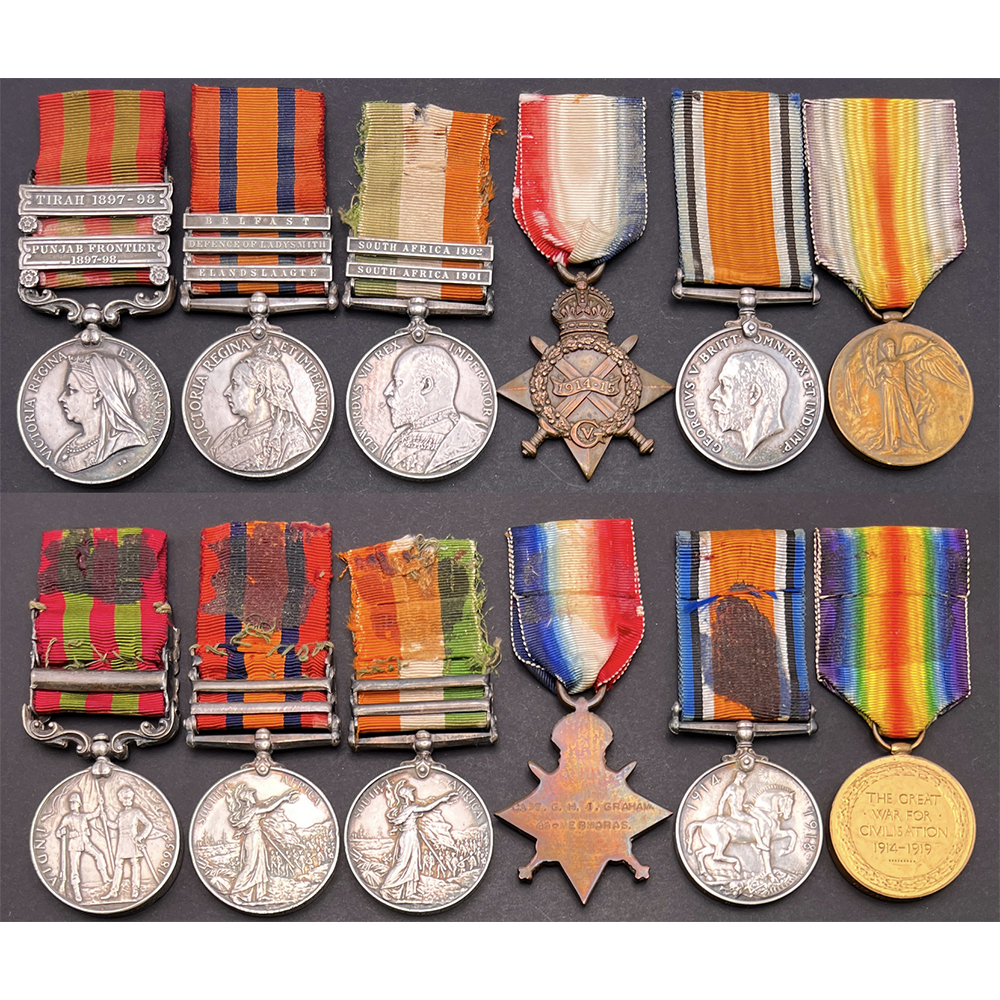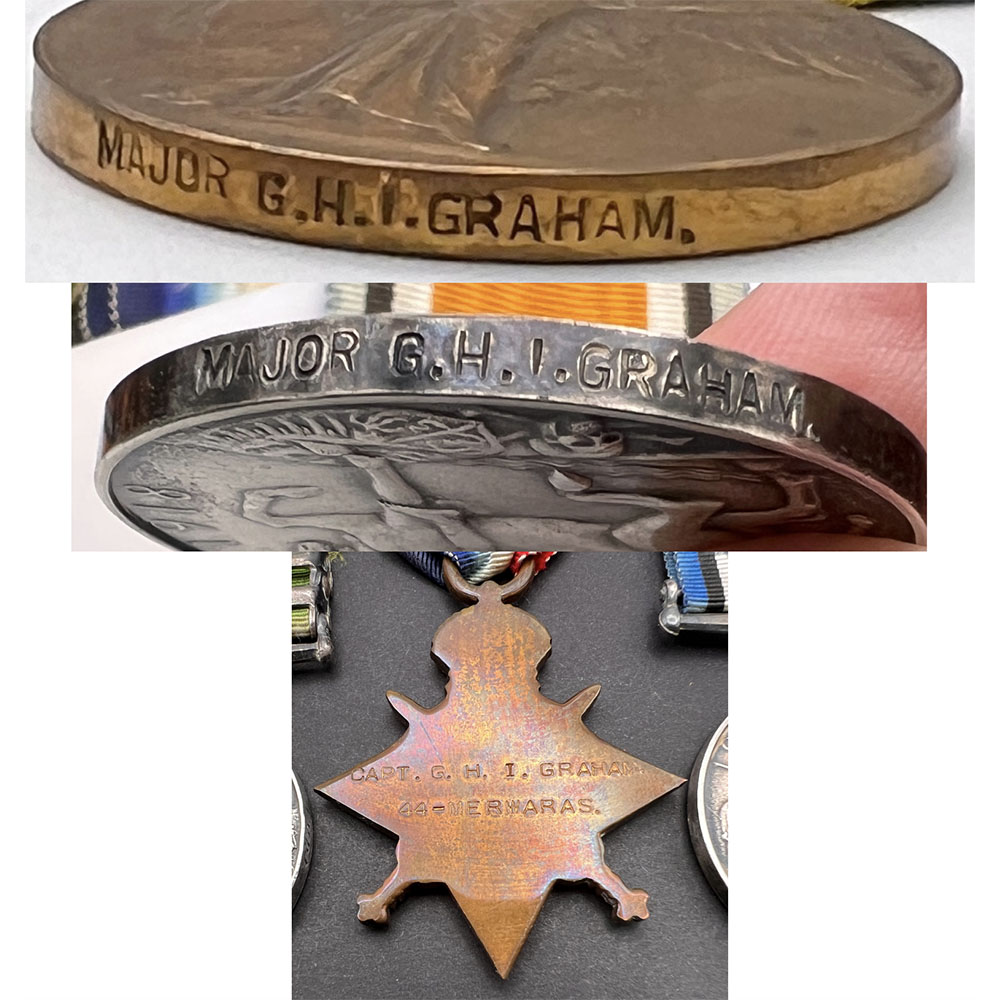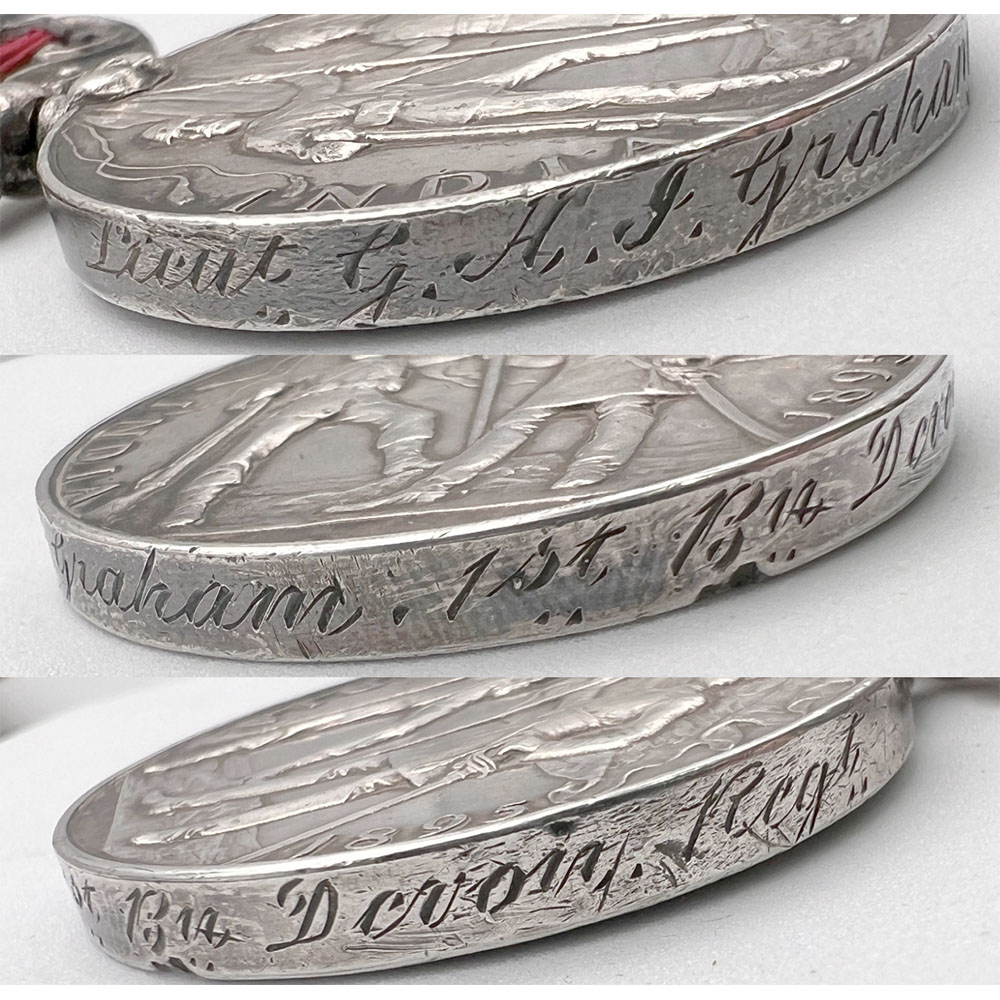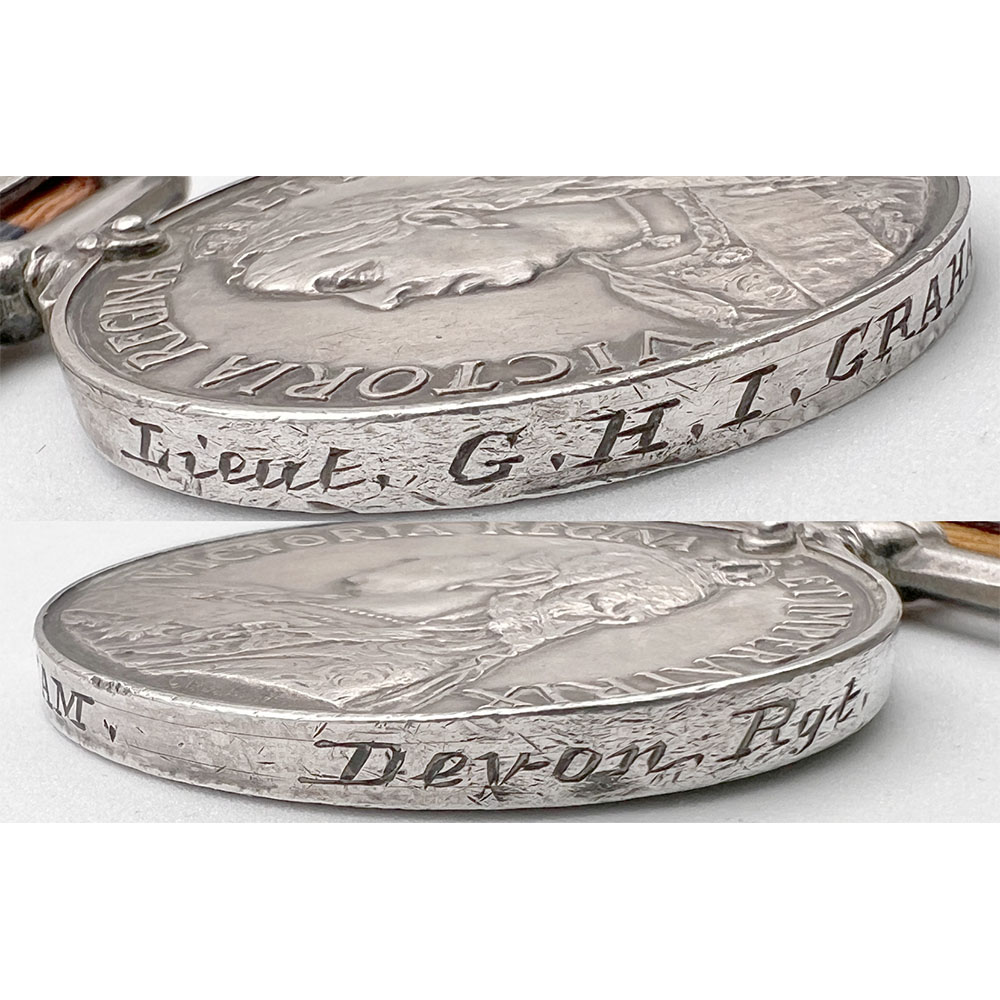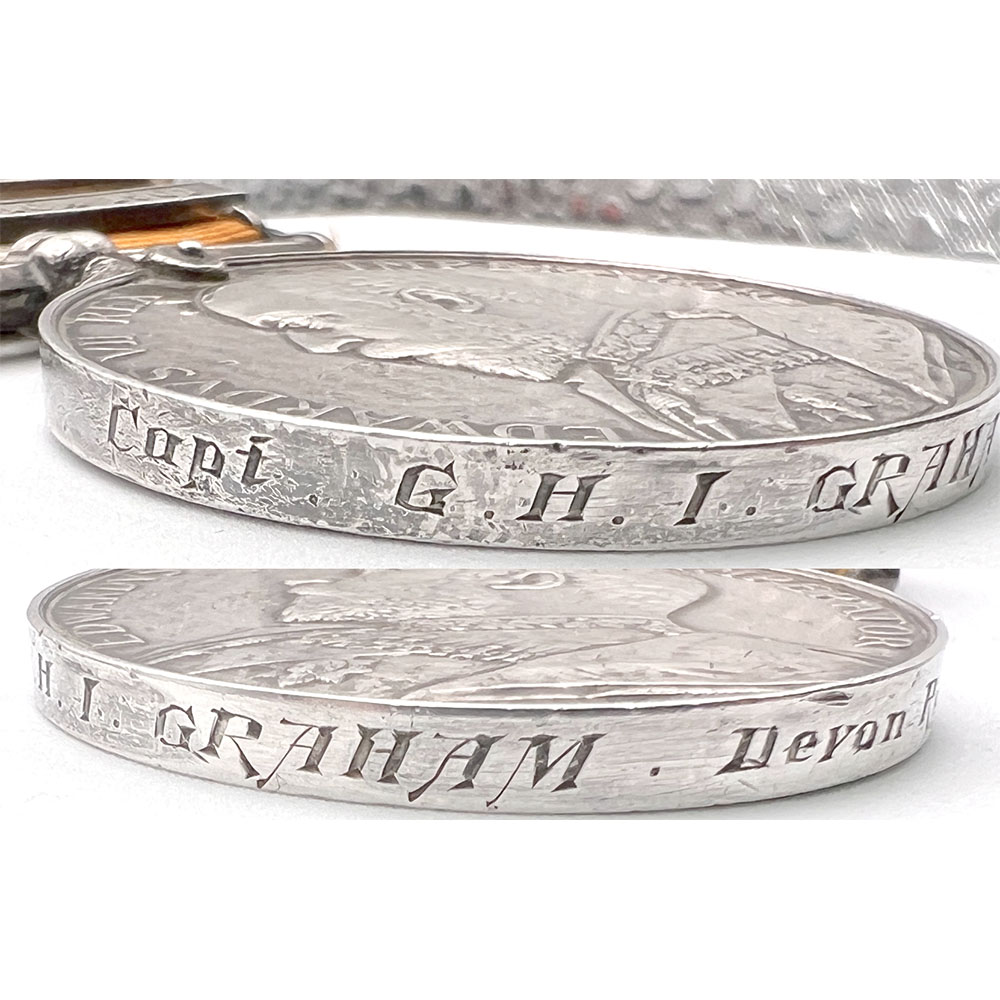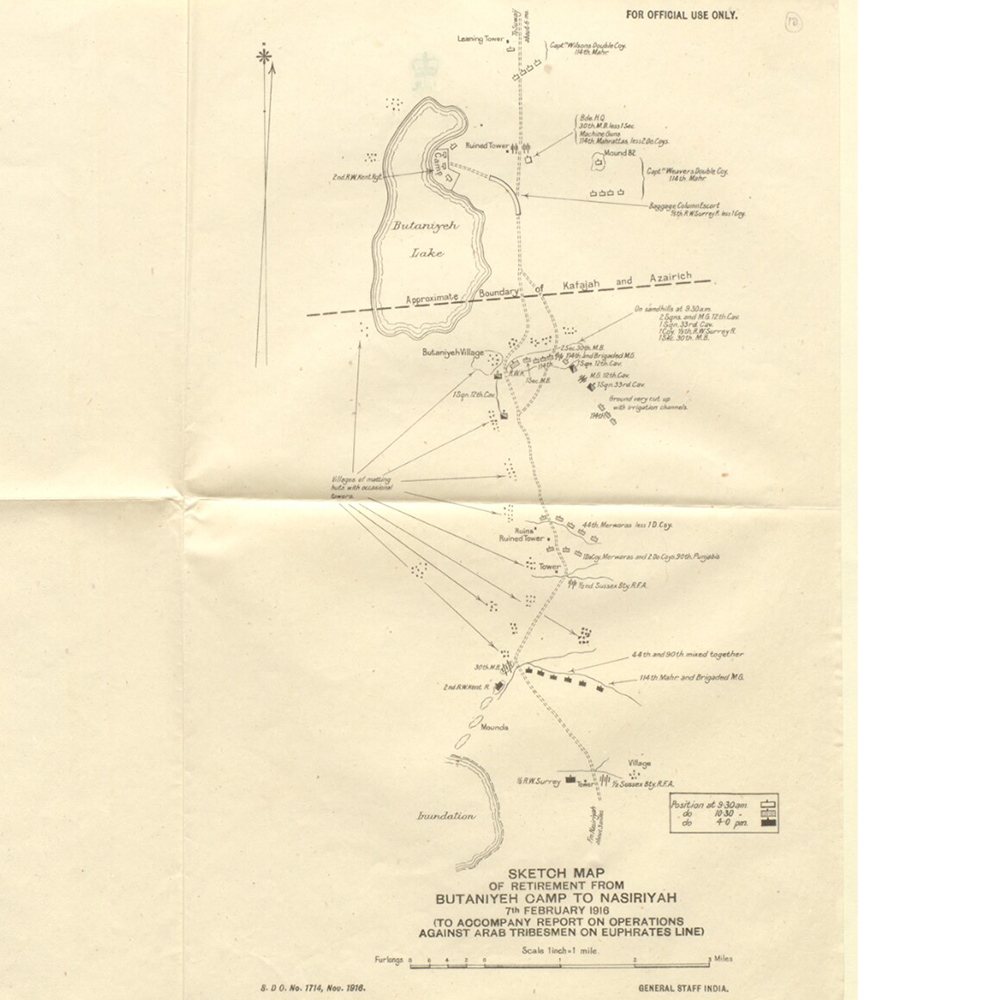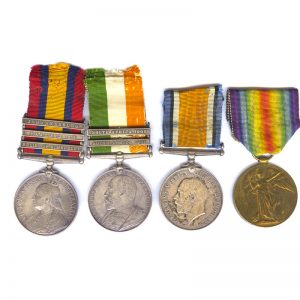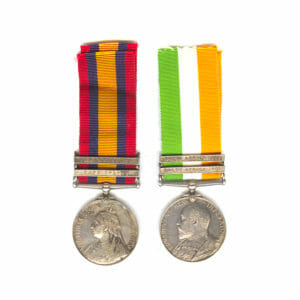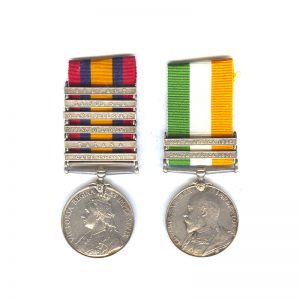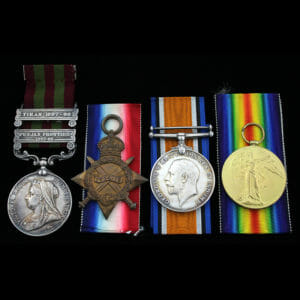Description
India General Service Medal 1895, 2 bars, Punjab Frontier 1897-98, Tirah 1897-98, Queen’s South Africa, 3 bars, Elandslaagte, Defence of Ladysmith, Belfast, King’s South Africa, 2 bars, SA 1901, SA 1902, 1914-15 Star, British War Medal & Victory Medal.
Major G.H.I. Graham, Devon Regiment, later 44th Merwara Infantry when killed in action during the Rearguard action on 7th February 1916 near Butaniyeh retreating to Nasariyeh, Iraq, he likely fought to the death greatly outnumbered by local Arab tribes previously believed to be friendly, the 44th Merwaras were quickly broken and the Indian troops, terrified, disobeyed orders from their officers, abandoning their line in the face of over 5,000 hostile Arabs.
“Arabs were seen sitting quietly in villages west of road north of Sandhills, who after troops had passed, walked out as spectators, then produced rifles from beneath their coats and shot into the backs of troops.” 2 days later Brigadier General HT Brooking CB sent an avenging punitive expedition “In consequence of the treacherous behaviour of certain sections of so called friendly tribes.”
India General Service Medal officially engraved in running script: “Lieut G.H.I. Graham. 1st Bn Devon Regiment.”
Queen’s South Africa officially engraved in officer’s style: “Lieut G.H.I. Graham. Devon Regt.”
King’s South Africa officially engraved in officer’s style: “Capt. G.H.I. Graham. Devon Regt.”
1914-15 Star officially impressed: “Capt G.H.I. Graham. 44-Merwaras”
British War Medal & Victory impressed: “Major G.H.I. Graham”
With 2 original photographs of recipient, one in contemporary gilt leather frame with stand, showing him in uniform pre-WW1 wearing his IGS, QSA, KSA, and a further original image of him in uniform with hat, with only one ribbon, looks like that of the IGS before the Boer War.
Services direct form his service records for his Devon Regiment service: “Commissioned Service in East Indies, 26th June 1897 – 20th September 1899 Tirah Expedition Force 1897-98, Present at CAPTURE OF SAMPAGHA PASS, CAPTURE OF ARHANGA PASS South Africa, 21st September 1899 – 18th January 1902 Present, Operations in Natal 1899 including the actions of Elandslaagte, Reitfontein, Lombard’s Kop, Defence of Ladysmith including the action on 6th January 1900 (Wagon Hill). Operations in Natal March to June 1900, Operations in Transvaal including the actions of Belfast, Lydenburg. Intelligence Officer at Machadorp, Sept 1901 – Nov 1901.”
George Humphrey Irving Graham was born on 2nd March 1873, the son of Major General George Farquhar Irving Graham, Bengal Staff Corps, who was great friends with Sir Syed Ahmad Khan CSI and the Aligarh Movement, he wrote his biography in 1885, playing an important role in the history of Indian Muslims as Director of Public Education for the N.W. Provinces. (His father’s Indian Mutiny Medal sold in Noonans during 2019).
He began his army service on 23rd October 1891 at the young age of 18, standing a commanding 6 feet 1 inch tall, speaking French & Urdu, he rose to the rank of Sergeant in the 2nd Dragoons, Scots Greys until 6th July 1897 when he was granted a commission as 2nd Lieutenant with the 1st Battalion Devonshire Regiment. The Nottinghamshire Guardian 1st January 1898:- “FROM THE RANKS, The Scots Greys is able to boast of having graduated through its ranks, first as privates, as many as six officers, all at present serving in other corps. Their names are :- Sergeant George Humphrey Irving Graham, who is gazetted to the Devonshire Regiment as Second Lieutenant….”
INDIA SERVICE
As soon as he was commissioned, the Devons were sent to India he took part in the campaign in the Punjab Frontier & the bloody Tirah campaign against the Afridis, during which he took part in the Capture of the Sempagha Pass and Arhanga Pass. Lieut Graham progressed through the difficult mountains with his battalion and fought to capture the Sampagha Pass leading to the Mastura Valley on 29th October in company with the K.O.S.B., 2 days later on 31st October he took part in the capture of the Arhanga Pass leading from Mastura into the Tirah Valley, capturing these narrow and treacherous passes allowed the main column to start inflicting punitive actions against the tribes, burning villages, crops, confiscating all weapons.
Unfortunately, the baggage trains and scouting parties were not as lucky, being the subject of various ambushes and fell victim to Guerilla Warfare. Upon the battalion departure Major General Symons published the following:
“In losing the 1st Bn Devonshire regiment from the 1st Division, the Major General Commanding desires to record his great appreciation of the good services through the campaign to this particularly efficient battalion. It is returning to Cantonments solely on the recommendation of the Medical Officer and on account of the scanty numbers to which it had been reduced owing to fever and sickness previously contracted in the Peshawar Valley, it has been a great pleasure to the Major General to have this extremely well behaved and good fighting West Country Regiment in his command.”
After the campaign was finished, Lieut. Graham, with 24 other Officers, 1 W.O. and 842 Other ranks were put on a Train on 16th September 1899 for Bombay from Jullunder, they set sail for South Africa, being one of the first regiments to arrive for war in South Africa on 21st September 1899.
SOUTH AFRICAN BOER WAR SERVICE
During the Boer War he took part in the following actions: Operations in Natal during 1899 including Battle of Elandslaagte, Reilfontein, Lombards Kop. He was also present during the Defence of Ladysmith including the action on 6th January 1900, known as the Battle of Wagon Hill (Platrand) on this day Boer Storming Parties under General CJ De Villiers began climbing Wagon Hill and Caesar’s Camp , after being spotted by British working parties who were emplacing guns, the Boers captured the edges of both areas but could not advance any further, the British also failed in their counter attacks.
At noon, de Villiers made another attack on Wagon Hill, some exhausted defenders panicked and fled, but Hamilton led reserves to the spot and recaptured some empty gun pits, late in the afternoon a terrific rainstorm broke out, leading the Boers to withdraw under the cover of it. During this battle the British lost 175 Killed and 249 wounded, with 52 dead Boers left in British Positions they attempted to take.
He then took part in the operations in Natal from March to June 1900, followed by operations in Transvaal, including the battle of Belfast & Lydenburg. The Morning Post, London 12th December Reports him on their casualty list as having been discharged from Hospital to duty during the week ending 2nd December 1900 for an unknown reason.
From September 1901 to November 1901 he was Officiating Intelligence Officer at Machadodorp. He then returned to India with his Regiment on 19th January 1902 until 27th February 1903.
After marrying at home he went to India with his wife, the Army Gazette 21st April 1906 stating “Devonshire Regiment – Capt. G.H.I. Graham seconded for service as Adjutant of Indian Volunteers (February 8)” He also served as Adjutant of the East Indian Railway Volunteers during March 1903.
In 1911 he officially transferred to the Indian Army, the Army Gazette 25th March 1911: The King has approved of the admission of the under mentioned officer to the Indian Army:- Capt G.H.I. Graham by exchange from Devonshire Regiment, February 18, Capt. Grahams rank is post-dated to July 7 1906, and his rank as Lt to Oct 7 1899. World War 1 Service and Death in Action Throughout the war until his death Major Graham was serving with the 44th Merwara Infantry, he met his end attempting to Relieve the Siege of Kut. When the war broke out the regiment arrived for service in Mesopotamia during early 1915 and took part in the Battle of Shaiba, Southern Iraq.
BETRAY BY FRIENDLY ARAB VILLAGES
Obituary in Dundee Courier & Daily Record 12th February 1916: “BLAIRGOWIE MAJOR IS KILLED IN ACTION. Yesterday it was learned with regret in the Blairgowrie district that Major George Humphrey Irving Graham The deceased served in the ranks of the Scots Greys for five years, and then received a commission in the 1st Devonshire Regiment.
In the Tirah campaign he received the medal and two clasps; in South African war he took part in the Defence of Ladysmith and gained the King’s and Queen’s medals and five clasps. In 1911, he exchanged into the Indian Army. His widow and children resided at Stewart-town, Rosemount.”
PERSONAL LIFE AND FAMILY
After returning home from two long campaigns he married his wife in 1903, reported by the Dundee Evening Telegraph on 24th November 1903: “FASHIONABLE BLAIRGOWRIE WEDDING (By a Lady Correspondent) Yesterday a very pretty wedding took place in St Catherine’s Church, Blairgowrie, the contracting parties being Miss Lilias Hunter Hill-Whitson, eldest daughter of Mr Charles Hill-Whitson of Parkhill, Blairgowrie, and Captain George Humphrey Irving Graham, Devonshire Regiment, Son of General Graham. The Bride was given away by her Brother, Captain E. Hill-Whitson (14th King’s Hussars), and was attended by her two sisters, Misses Beatrix and Marjorie Hill-Whitson. Captain Reginal Wrey, Devonshire Regiment acted as Groosman.
The Ceremony was performed by the Venerable Archdeacon Aglen and Rev. F.W. Davis. The church was very tastefully decorated with white chrysanthemums and lilies, having tall palms and ferns for backgrounds. The Bride entered the church leaning on her brother’s arm, and looked charming a gown of ivory satin. The skirt was plain, with cream applique, and the bodice was trimmed with yoke and berthe of rucked chiffon, the berthe and sleeves being with Beautiful Old Brussels Lace. She wore a beautiful veil, and carried exquisite bouquet of lilies of the valley and maidenhair ferns.
A reception was held afterwards at Parkhill by Mr and Mrs Hill-Whitson, early in the evening the Bride and Groom left for their honeymoon, the bride wearing a dress of dark blue cloth trimmed with green appliqué and a blue straw hat trimmed with green also. The present were handsome and numerous.”
In June 1939, aged 28, His only son, Neil Malise Graham, having just fathered twin sons 11 weeks earlier, was found dead in a wrecked sports car which had crashed into a lamp post in Hills Road, Cambridge.
Attached map of the battle reproduced courtesy of the Qatar Digital Library, who have a digitised full report available online of the operations by General Sir Percy Lake, Commanding. Sketch Map of the Retirement from Butaniyeh Camp to Nasiriyah [19] (1/1), British Library: India Office Records and Private Papers, IOR/L/MIL/17/15/107, p 19, in Qatar Digital Library Full report of the battle on 7th February 1916:
An account of the action is noted in a letter from a report by the Commanding Officer and the full account of the month from Sir Percy Lake, is digitised by the Qatar Archives: From: Brigadier-General E. C. Tidswell, D.S.O., Commanding, 84th Indian Infantry Brigade To: The General Officer Commanding, Nasiriyah I have the honour to forward an account of the action that took place on February 7th, along with a list of my recommendations. Account of the retirement of a force under Brigadier-General E. C. Tidswell, D.S.O., from Butaniyah to Nasiriyah on February 7th, 1916. Reference attached sketch.
At 8:30 a.m., one double company of the 11th Mahrattas, led by Captain B.C. Wilson, occupied Leaning Tower, relieving the night piquet of the 2nd Battalion, Royal West Kent Regiment. They reported approximately 20 Arabs about 2,000 yards north of their position. At 9:10 a.m., they reported that Arabs were gathering from all sides.
At 8:30 a.m., one double company of the 114th Mahrattas, led by Captain H. Weaver, occupied Mound 82. At 9:30 a.m., they reported Arabs moving from the north and east, approximately 1,300 yards away. At 8:12 a.m., one squadron and machine gun section of the 12th Cavalry, one section of the 30th Mountain Battery, and one company of the 1st Royal West Surrey Regiment, under Major S. M. Tahourdin of the 12th Cavalry, occupied the sand hills on the Nasiriyah road and reported that everything was clear.
At 9:15 a.m., the 30th Mountain Battery (except for one section) and the 114th Mahrattas (except for two double companies), along with the brigaded machine guns and Brigade Headquarters, took up a position at Ruined Tower.
At 9:40 a.m., the baggage moved clear of the camp to the starting point with an escort from the 1st Battalion, Royal West Surrey Regiment (except for one company). The 2nd Battalion, Royal West Kent Regiment, occupied the camp site and prevented Arabs from entering. Around 9:15 a.m., the guns at Ruined Tower opened fire on a group of Arabs near Leaning Tower.
At 9:36 a.m., Captain R. C. Wilson’s double company from Leaning Tower withdrew towards Mound 82, and the 2nd Royal West Kent Regiment moved approximately 500 yards away from the camp. The Arabs immediately occupied the camp and began firing. Around 10 a.m., the baggage successfully crossed the sand hills, and the force withdrew. Captain H. Weaver’s double company on Mound 82 withdrew when Captain R. C. Wilson’s double company was behind it. Later, it was reported that the double company from Mound 82 suffered heavy losses during this retreat, but the Officer Commanding the 114th Mahrattas at the sand hills was not aware of this.
At 9:40 a.m., we received information that Headquarters, one squadron of the 12th Cavalry, and one squadron of the 33rd Cavalry, all from Nasiriyah, were in position on the sand hills by 9 a.m.
Around 10:20 a.m., the force retired and took up a position on the sand hills. The Arabs followed us into the open ground and were constantly seen circling our right flank and on the east side of Butaniyah Lake. Up until that point, there were very few casualties, except for those suffered by Captain H. Weaver’s double company.
Arabs were observed sitting calmly Several of the 114th Mahrattas killed Arabs on the ground and took their rifles into the villages. One of these villages was heavily shelled at short range by the 30th Mountain Battery. Afterward, I ordered the clearance of villages that were close on our left flank. One squadron of the 12th Cavalry and the 2nd Battalion, Royal West Kent Regiment, were instructed to support each other from village to village. One squadron of the 12th Cavalry occupied Butaniyah village and the one south of it, both of which they cleared. The rest of the cavalry were on the right flank of the sand hills, with the machine guns positioned about 500 yards back.
Around 10:30 a.m., we received information that the 44th Merwaras and 400 rifles from the 90th Punjabis were occupying a position about one mile from the sand hills towards Nasiriyah. The l-4th Sussex Battery, E.P.A., was on their right rear, all under the command of Colonel Dunlop from the 44th Merwaras. Upon receiving this information, I informed Colonel Dunlop that we would retire through his position, and he would cover our retreat. One double company of the 114th Mahrattas, along with the brigaded machine guns, retired approximately 1,500 yards on our right flank. They were joined by another double company of the 114th Mahrattas when the sand hills were vacated. The 30th Mountain Battery (except for one section) on the left also retired, leaving the 2nd Battalion, Royal West Kent Regiment, and one double company of the 114th Mahrattas holding the sand hills. Around 11:45 a.m., the dismounted cavalry retired, and the retreat proceeded normally.
At 12:45 p.m., I received a message from the Royal West Kent Regiment requesting reinforcements. I sent up one company of the 41st Merwaras from the position occupied by the 44th Merwaras, which I had reached at that time. Colonel Dunlop showed me the position he had taken up, with the 44th Merwaras on the right and left of the road, the right flank well thrown back. One double company and the 90th Punjabis were positioned 800 yards in the rear, with the l-2nd Sussex Battery approximately 1,500 yards on the right rear of the first line. The 2nd Battalion, Royal West Kent Regiment, and 114th Mahrattas then passed through the 44th Merwaras, with the 90th Punjabis in support.
Shortly afterward, Colonel Dunlop informed me that his infantry would not hold, and British reinforcements were needed. So I sent the Royal West Kent Regiment back into the firing line and recalled the l-5th Battalion, Royal West Surrey Regiment from escort duty. In the center, I witnessed the Indian infantry collect into a mob of about 300, and the Arabs closed in on them and shot them. The cavalry on the left flank made a small charge, which, along with the accurate fire from the 30th Mountain Battery and the steady courage of the 2nd Royal West Kents, relieved the pressure.
However, some of the 44th Merwaras and 90th Punjabis continued to retreat and would not stop despite commands and threats until they reached the line near the second sand hills taken up by the l-2nd Sussex Battery, 30th Mountain Battery (except for one section), and machine guns, along with the 134th Mahrattas. The cavalry on the right flank were heavily attacked at this time and suffered most at this time heavily attacked and suffered most of their losses.
The 1-5th Royal West Surrey Regiment were on the right rear about 4pm This was practically the Arab’s last effort and they gradually withdrew after having followed us persistently since about 9:30am trying to turn both flanks. The force then withdrew unmolested into Nasiriyeh.

